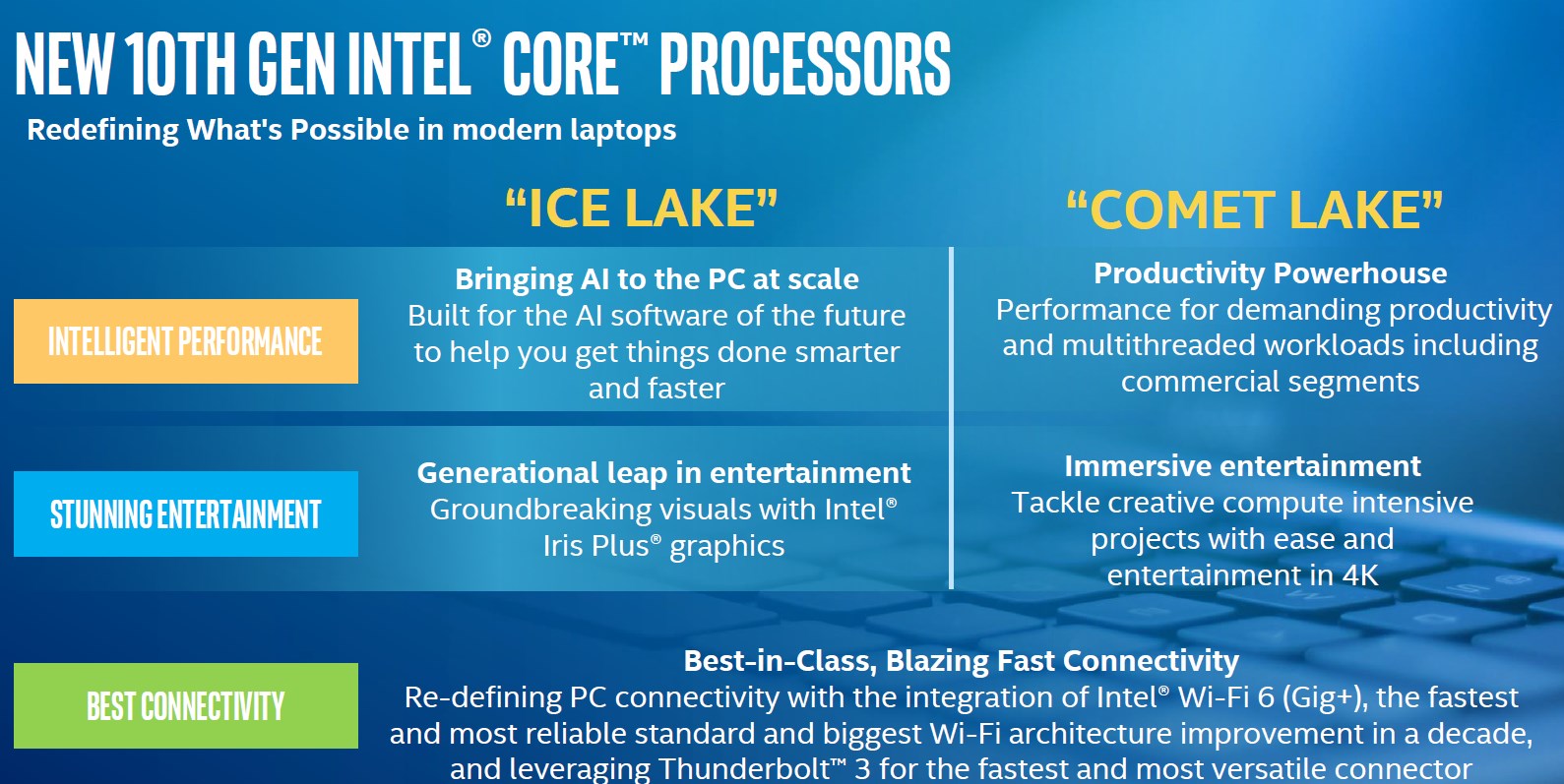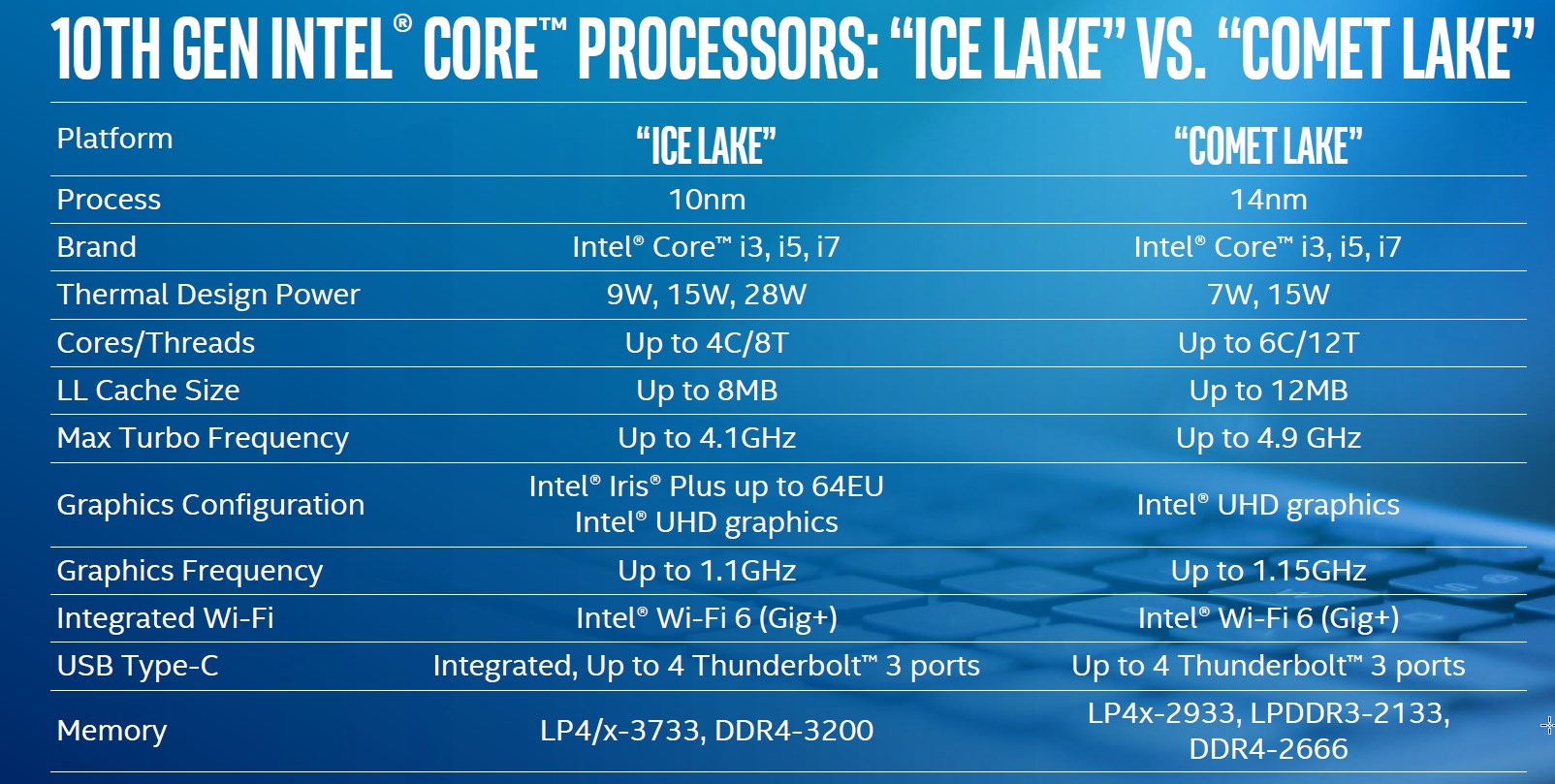On heels of its 10th generation “Ice Lake” processor release, Intel today also announced its “Comet Lake” series of mobile processors.

Comet Lake: What’s new (and the same)?
Unlike Ice Lake, Comet Lake is built on Intel’s 14nm node–the same node used for Intel’s 8th gen “Whisky Lake” mobile processors. Compared to Whiskey Lake, Comet Lake’s base frequencies, single-core turbo frequencies, and all-core turbo frequencies have all received a marginal bump (100 MHz to 200 MHz).

Frequency boost aside, there are no significant changes to the Comet Lake’s core architecture. What is new, however, is a new 6-core, 12-thread Core i7-10710U occupying the top end. This marks the first time Intel has introduced a 6-core part to the U series. And despite the core count increase, its nominal thermal design power (TDP) is still capped at 15W. Given such a tight thermal envelope, it’s no surprise that it features a 1.1 GHz base frequency–nearly half that of the other chips in its family. And while Intel specifies a 3.9GHz all-core turbo frequency, it’s questionable how long it can maintain that before throttling.
Also new is the Platform Controller Hub (PCH) and improved memory support. Ice Lake’s PCH has trickled down to Comet Lake, and with it, it brings native support for integrated Intel WiFi 6 AX201. Interestingly, Intel’s slide deck doesn’t mention anything about a Thunderbolt controller on the PCH, which was one of Ice Lake’s highlights.

Comet Lake’s memory controller now supports dual-channel LPDDR4x for better memory power savings. Since there’s little architecture change, the new memory controller comes as a surprise as it’s baked into the processor die.
Intel Adaptix automatic tuning technology makes a return on Comet Lake. It can dynamically adjust power settings based on usage mode and temperature using machine learning algorithms to predict workload. Intel says that it can boost performance by up another 8 to 12 per cent.

Little has changed on the graphics side. Although it’s received a 100 MHz frequency increase across all parts, they’re still Intel’s 10th gen UHD 620 graphics featuring 24 EUs. In comparison, Ice Lake’s 11 gen graphics has up to 64 EUs.
Ice Lake’s configurable TDP bottomed out at 9W, leaving a gap for parts with 7W TDP and under. That gap has now been filled by Comet Lake Y series chips, which start with 4.5W configurable TDP. They will be used in fanless ultraportable designs.
Ice Lake vs Comet Lake
Intel describes Comet Lake as a “productivity workhorse”. Meanwhile, Ice Lake is supposed to “bring AI to the PC at scale. Their intended audiences are fairly clear cut. Those seeking a robust gaming experience and the latest AI features should opt for Ice Lake, for everyone else, there’s Comet Lake.

The greatest difference between Ice Lake and Comet Lake is graphics. Ice Lake’s gen 11 Iris Plus graphics has 64 execution units (EUs), more than twice that of Comet Lake’s 24. Gen 11 graphics also touts a pair of HEVC transcoders, a better memory design, and support for VESA’s adaptive sync. At Intel Blueprint event where Ice Lake was first announced, the gen 11 graphics was shown to output 1.8 times higher frame rate in Counter-Strike: Global offensive.
On the processor front, Ice Lake is manufactured on Intel’s newest 10nm node, and boasts up to an 18 per cent instructions-per-clock increase over the previous generation. More importantly, it supports new instructions specific to AI and cryptography. Deep Learning Boost, an AI inference acceleration feature, can increase performance by up to 2.5 times under certain AI workloads. All these features are missing on Comet Lake.

While Ice Lake’s graphics is objectively superior to Comet Lake, their performance should be much closer in everyday CPU workloads. And in the highest-end U series, it’s unlikely that a 4-core Ice Lake part can outperform the 6-core Comet Lake part in multithreaded tasks.
A Word on naming
Intel’s naming scheme has been confusing ever since its 8th generation processors launch. With the 10th generation encompassing both Whiskey Lake and Comet Lake processors, Intel has taken a new approach at decluttering its naming scheme.

Ice Lake is divided by their graphics performance. So the easiest way to differentiate them is to remember that they all end with a “Gx” suffix (G7, G4, or G1). On the other hand, Comet Lake processors have five numbers all beginning with “10” (Core i7-10750, for example) and end with either Y or U suffix.
But it’s important to remember that Ice Lake has U and Y parts too. Because their suffix positions are already populated with Gx, all Ice Lake U-series end with a 5 before the Gx suffix, while the Y-series all end with 0. This rule doesn’t apply to the Core i7-1068G7 for whatever reason. Easy to remember, right?
And this is just the launch line up. As more refined versions and segmented chips populate the lineup down the road, the naming scheme will only get messier.
Intel Comet Lake will be arriving in more than 90 designs this holiday season.
